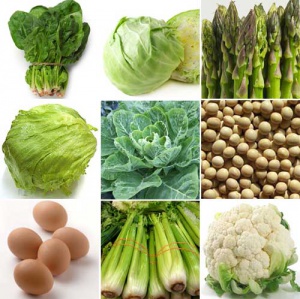Vitamin K
Contents
Description
Needed for the posttranslational modification of certain proteins, vitamin K mainly assists the functions of the coagulation of blood but also the main metabolism pathways in bone and other body tissue. Also known as phylloquinone, phytomendione/phtonadione, or menaquinone/menatretrenone, vitamin K is created by bacteria in the large intestine. Deficiency rarely occurs unless the intestines sustain great damage, which prevents absorption of vitamin K or are decreased in production by regular flora as shown in broad spectrum antibiotic uses. Three types of synthetic forms of vitamin K exist: vitamin K3, K4, and K5, all of which are use in various areas. K3 is used in the industry of pet foods and K5 is used to prevent and protect against fungal growth.
Health Benefits
There are a variety of health benefits provided by vitamin K that protect us from illness, injury and internal complications. Many benefits that are offered by vitamin K include the enabling of normal blood clotting, protects the bones from fracture, prevention of postmenopausal bone loss and calcification of the arteries, protect against liver and prostate cancers, protects against osteoporosis and excessive menstrual flow, prevents and protects against internal bleeding and jaundice, assists with menstrual pains, provides nausea and vomiting relief for pregnant women, prevents and protects against hemorrhage in newborns and infants, assists in normalizing digestion, helps with protecting the immune system, regulates and normalizes blood sugar, and increases the overall longevity and vitality of life.
Beauty Benefits
The beauty benefits of vitamin K are much less widely known than other vitamins such as vitamin C, but they can be just as beneficial as the former and sometimes more in certain cases of beauty problems. Since vitamin K helps to improve blood circulation, it may be shown to smooth fine lines and wrinkles, improve tone, texture and color of the skin, and help normalize the water-fatty balance of the skin. Vitamin K may help with diminishing spider veins and bruising, heal and maintain healthy skin conditions, and moisturizes the skin, relieving dryness and itchiness.
Food Sources
Vitamin K can be found in a variety of food sources as well as even in small amounts in goat and cow milk. Other food sources to consume for the benefits of vitamin K include but are not limited to:
- Spinach
- Brussel Sprouts
- Collard Greens
- Kale
- Lettuce
- Asparagus
- Celery
- Soybeans
- Cauliflower
- Eggs
- Cereals
- Wheat Bran
Daily Dose Recommendations
- Infants: 0-6 Months 2Mg/Day, 7-12 Months 2.5 Mg/Day
- Children: 1-3 Years 30 Mg/Day, 4-8 Years 55Mg/Day, 9-13 Years 60 Mg/Day, 14-18 Years 75 Mg/Day
- Adults: Males 19+ Years 120 Mg/Day, Females 19+ Years 90 Mg/Day, Pregnant or Lactating Females 18 Years or Less 75 Mg/Day, Pregnant or Lactating Females 19+ Years 90 Mg/Day
Side Effects
There are no known side effects of vitamin K, although too much vitamin K intake can negatively interact with anticoagulant medications.
Deficiency
Vitamin K deficiency is very rare and seems to only occur when the intestinal tract sustains damage and cannot absorb the vitamin. It can also occur after the prolonged use of one or more oral antibiotics, which can destroy some of the bacteria used to produce vitamin K in the body.
Related Discussions
- Vitamin K Error?
- Vitamin K2 Shown to Reverse Arterial Calcifications
- Vitamin K2 Marked to Stand Next to D3
